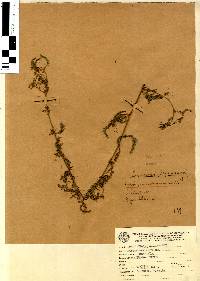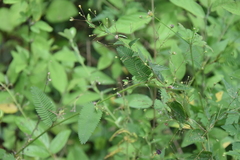
Neotropical Flora
|
Family: Fabaceae
[Aeschynomene americana var. depila Millsp.] |
Erect or somewhat reclining herb, l-3 m tall; stems and inflorescences sparsely hirsute. Leaves pinnate, 2.5-6.5 cm long, short-petiolate; stipules narrowly lanceolate, to ca 12 mm long, with a narrowly lanceolate appendage ca 8 mm long at base pointing antrorsely; leaflets folding together top to top upon dessication, in mostly 12-30 pairs, oblong, obliquely apiculate, oblique at base, 6-9 mm long and less than 2 mm wide, +/- scarious, the costae 3, parallel, conspicuous below. Inflorescences axillary, racemose, to 5 cm long; bracts conspicuous, foliaceous, broadly lanceolate, to 3 mm long and 1.5 mm wide, the veins 5-15, conspicuous, parallel, the margins setaceous; pedicels to 10 mm long; flowers few, oblique on pedicels, to 9 mm long; calyx bilobed, hispid, to 5.5 mm long, subtended by 2 bracts nearly equaling calyx lobes; standard 8 mm long, rounded, pale orange with a yellow spot near its base, often marked with dark red as well, held erect at anthesis; wings slightly shorter than standard, the keel fused only on outer edge, loosely holding stamens and style; stamens in 2 clusters of 5 each, equaling length of style, shedding pollen before opening. Loments stipitate, 3-9-lobed, to 26 mm long and 2.5 mm wide, densely pubescent, the lobes ca 3 mm diam, the upper margin of loment +/- entire, the lower margin deeply constricted between each seed; seeds 2-3 mm long, 1.5-2 mm wide. Croat 13154. Occasional, in the Lighthouse Clearing. Flowers and fruits mostly from December to February. The plants are often more or less reclining in age, perhaps dispersing fruits by lateral displacement. The plant has been seen visited briefly by small black bees (possibly Trigona) in rapid succession. The fruits do not stick to clothing (at least before maturity), although they have many trichomes. |
Powered by Symbiota.



















